
“News Reels Make Movies of Diving Apparatus Here: Getting Publicity for Stone Harbor Saturday, October 11, 1930”
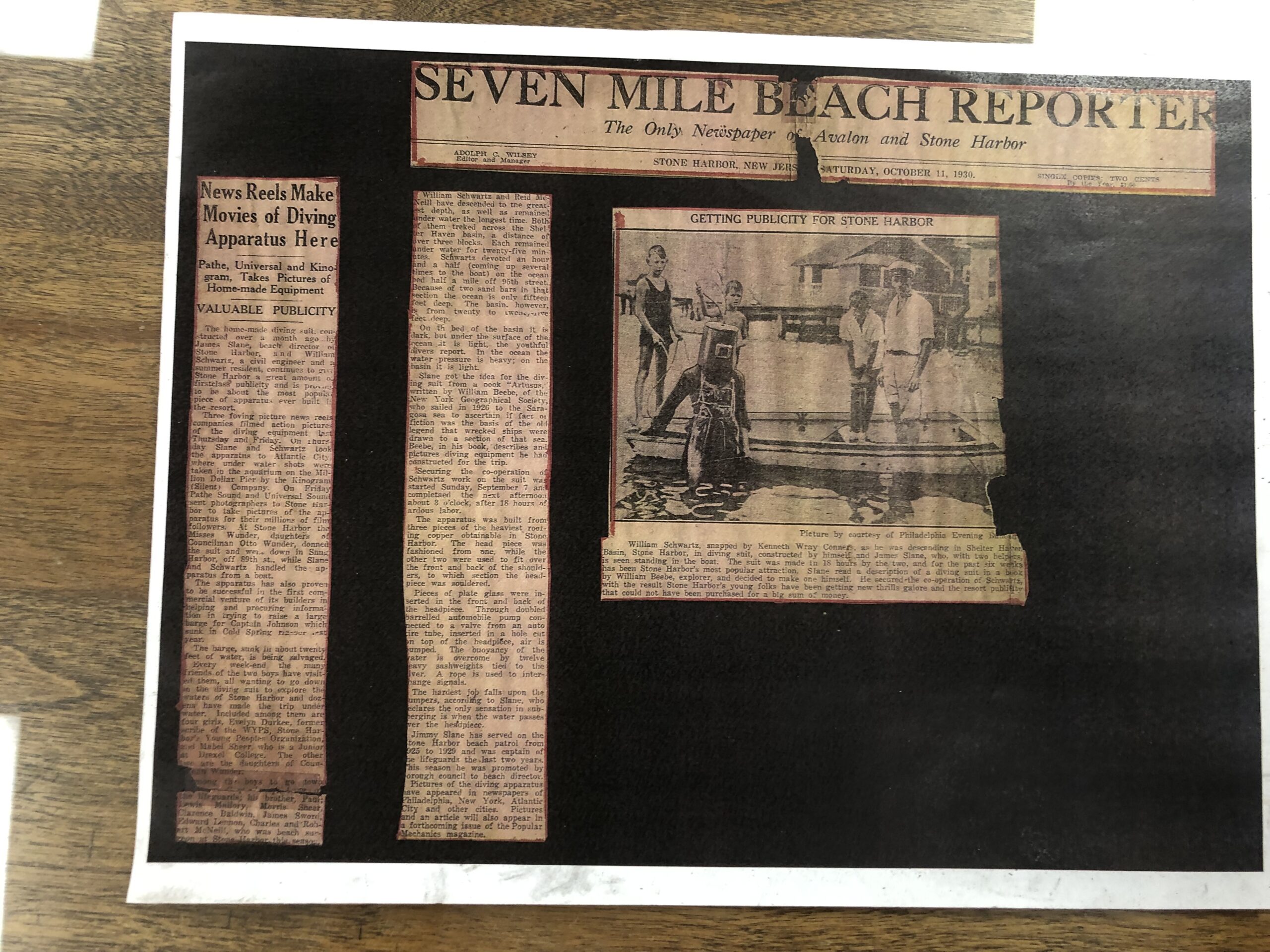
Introduction: Recently, I had the good fortune to travel to Stone Harbor, and while there, I visited the Stone Harbor Museum located at 9410 Second Avenue. By the way, if you have never been to the museum, then you are in for a real treat. With a mission dedicated to preserving and sharing the history of Stone Harbor, more than 100 years of history await you at the wonderful Stone Harbor Museum. There are many artifacts on display along with vintage maps, photographs, oral histories, and much, much more. The volunteers who serve to maintain this facility and keep it open to the public are dedicated, friendly and most welcoming. Admission is free. Summer hours are from 10 AM to 1 PM, Monday thru Saturday. For off season hours and events, please check the museum website: www.stoneharbormuseum.org. The Stone Harbor Museum phone number is: (609) 368-7500. You will definitely want to put this museum on your “Things To Do List” the next time you visit or vacation at Stone Harbor.
While I was at the Stone Harbor Museum, I discovered more exciting information about the resort’s rich history.
One of my great finds included coming upon a fascinating story (see newspaper clipping shown above) that was published in a local 1930 newspaper article. Specifically, the publication that carried the story along with a picture with caption was the “SEVEN MILE BEACH REPORTER – The Only Newspaper of Avalon and Stone Harbor – STONE HARBOR, NEW JERSEY – SATURDAY, OCTOBER 11, 1930”.
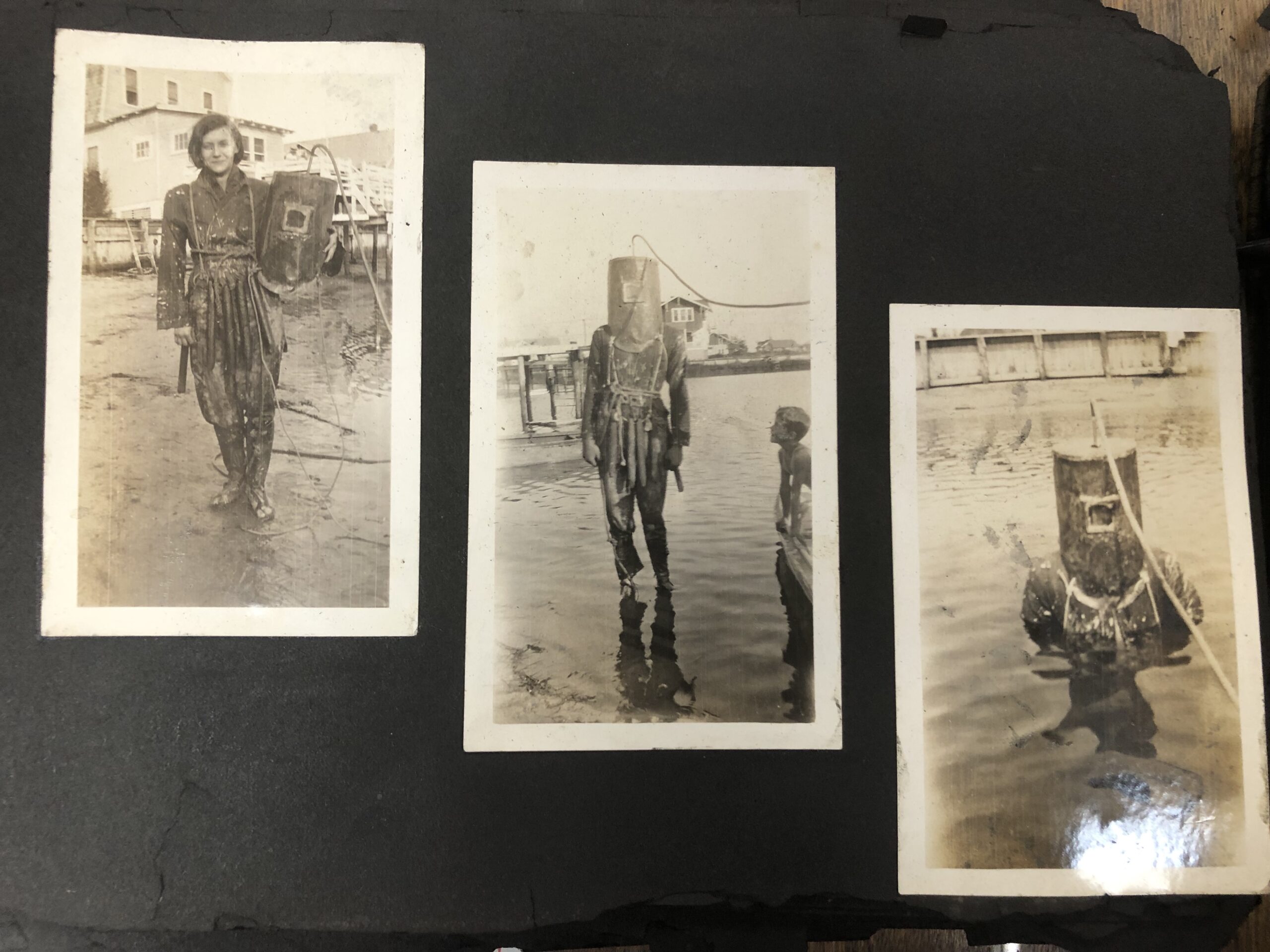
In addition, I came upon a total of 7 unique personal photographs in the museum’s archives that supported this newly discovered fascinating story. To my great surprise, here for example is a trio of such snapshots that I located nicely mounted on one of the pages in a magnificent Stone Harbor scrapbook with many, many photos that Nancy Calvetti had acquired in Ocean City and donated to our museum. Without a doubt, this single aging photo scrapbook is a real treasure trove in and of itself with such a vast array of photos! Surely you can imagine my great excitement finding such photos. Now I needed to assemble all the pieces of information and images and put the story together in a form suitable for posting and sharing with others on both our Facebook/Meta group page as well as our museum website. Therefore, this special stand-alone article is all about telling the story of something quite unusual that received widespread publicity that occurred in October of 1930. So, here goes…
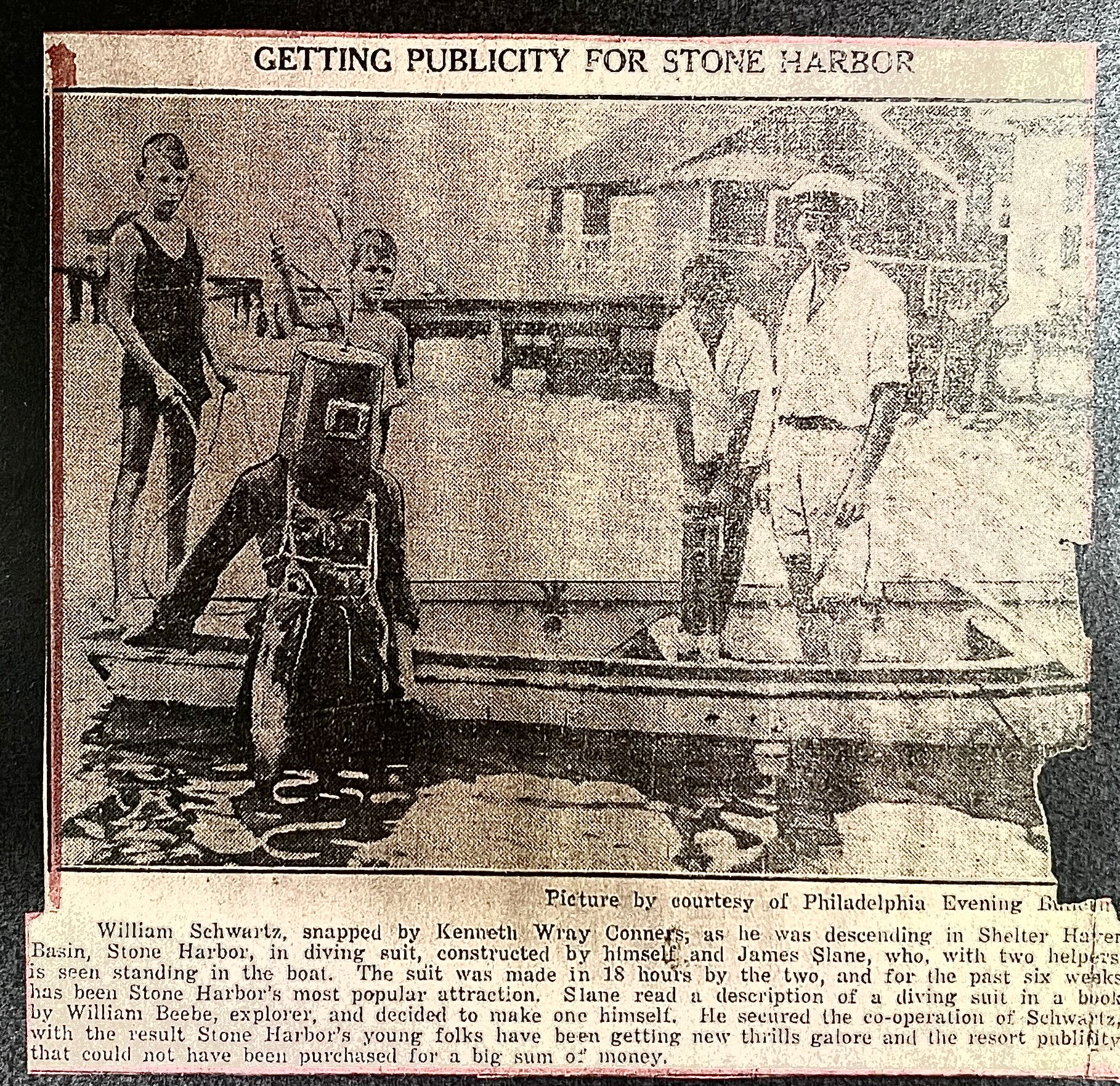
This particular image accompanied the aforementioned article and as you can see is titled “GETTING PUBLICITY FOR STONE HARBOR”. The credit for this rather grainy or poorly reproduced image states: “Picture by courtesy of Philadelphia Evening Bulletin.” The following paragraph consists of exactly the very same words that were used originally and that appeared in this caption.
“William Schwartz, snapped by Kenneth Wray Conners, as he was descending in Shelter Haven Basin, Stone Harbor, in diving suit, constructed by himself and James Slane, who, with two helpers is seen standing in the boat. The suit was made in 18 hours by the two, and for the past six weeks has been Stone Harbor’s most popular attraction. Slane read a description of a diving suit in a book by William Beebe, explorer, and decided to make one himself. He secured the co-operation of Schwartz, with the result Stone Harbor’s young folks have been getting new thrills galore and the resort publicity that could not have been purchased for a big sum of money.”
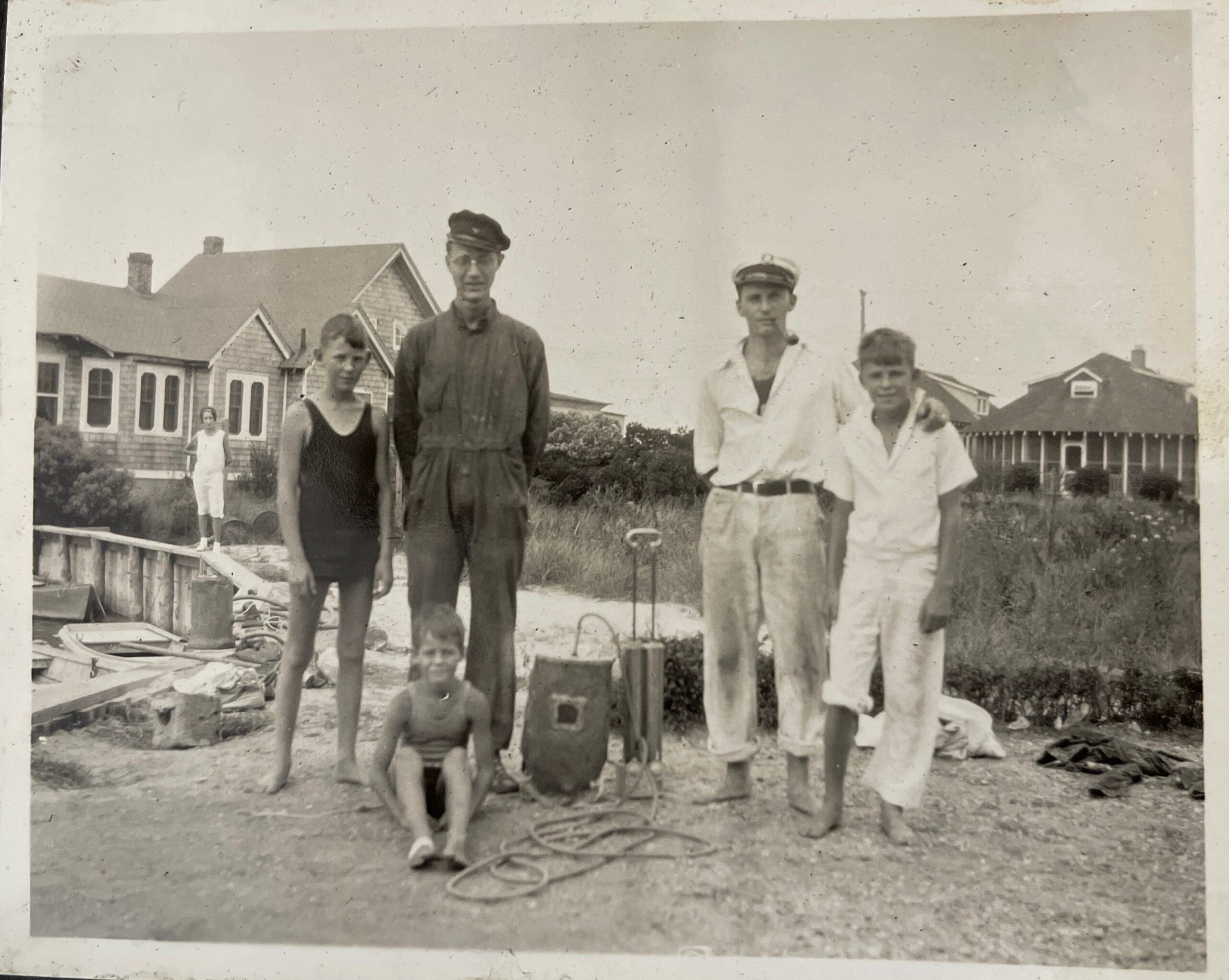
Illustrated here is the first of 7 new photo images that will be presented and interspersed throughout the somewhat lengthy article that is being featured here next. As we progress into the article you should find that some of these photos are quite dramatic and unusual to say the very least. I do hope you find this ongoing human interest account associated with Stone Harbor to be both interesting and captivating.
Starting with the image shown above, we only know the names of the 2 adult men and not the 3 young lads or the woman in the background. The gentleman standing on the left is William Schwartz. The other gentleman standing on the right is James Slane with a pipe in his mouth. For 5 years from 1925 to 1930 James Slane was a life guard at Stone Harbor and also served in 2 other positions (captain and beach director) associated with the Stone Harbor Beach Patrol. Their hand-made and unusual looking diving apparatus including headpiece and hand-pump are shown on the ground between them.
The complete article shown earlier that actually appeared in the October 11, 1930 edition of the “Seven Mile Beach Reporter” newspaper is now about to be presented to facilitate easy reading and is worded exactly as it was originally published. Due to the somewhat poor condition of the featured newspaper clipping, some areas or words are not visible or discernible. That being said, the title of the article and its subtitles are as follows: “News Reels Make Movies of Diving Apparatus Here / Pathe, Universal and Kinogram, Takes Pictures of Home-made Equipment / VALUABLE PUBLICITY”.
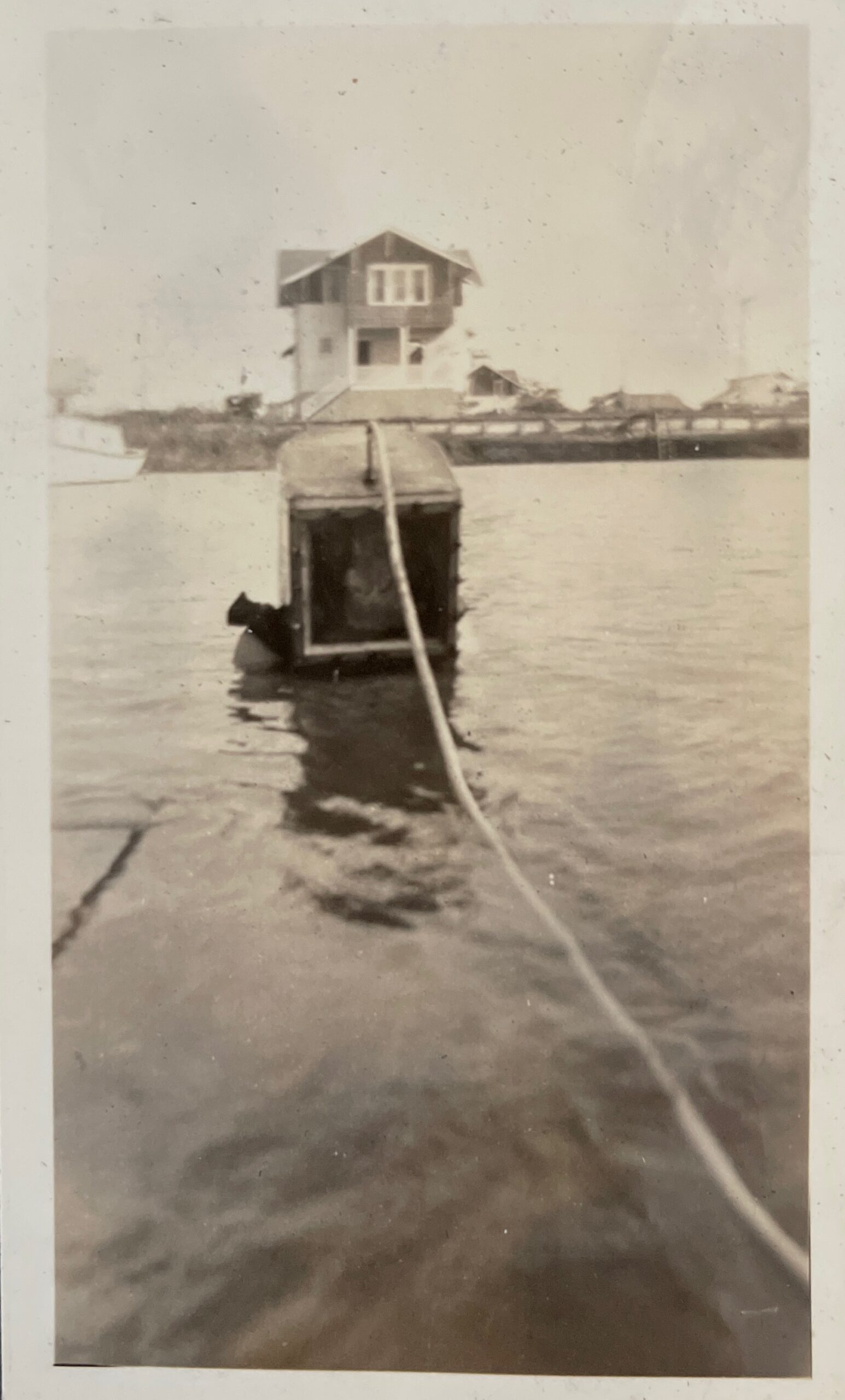
“The home-made diving suit, constructed over a month ago by James Slane, beach director of Stone Harbor, and William Schwartz, a civil engineer and a summer resident, continues to give Stone Harbor a great amount of first class publicity and is proving to be about the most popular piece of apparatus ever built in the resort.
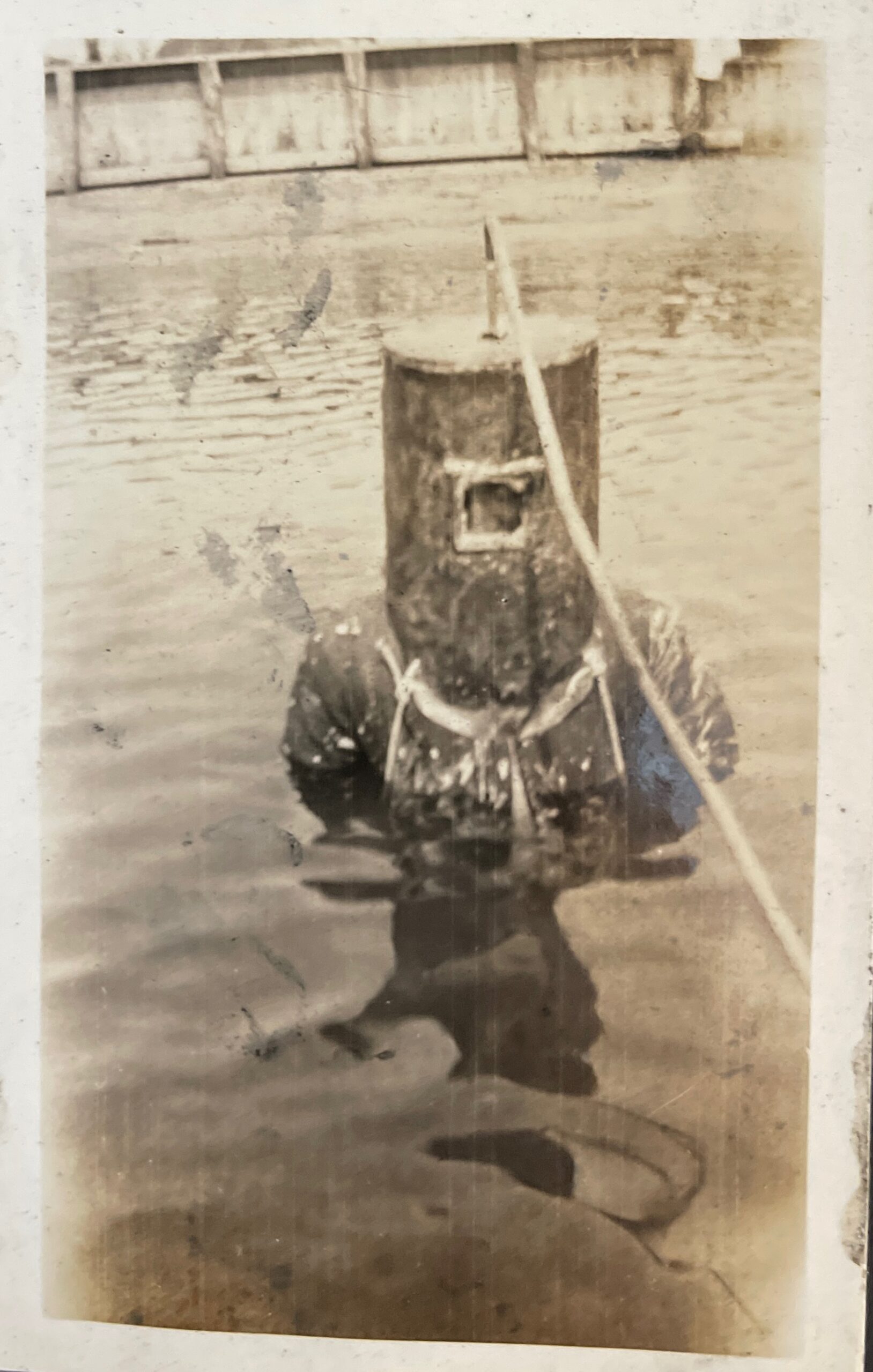
Three moving pictures news reels companies filmed action pictures of the diving equipment last Thursday and Friday. On Thursday Slane and Schwartz took the apparatus to Atlantic City, where underwater shots were taken in the aquarium on the Million Dollar Pier by the Kinogam (silent) Company. On Friday Pathe Sound and Universal Sound sent photographers to Stone Harbor to take pictures of the apparatus for their millions of film followers.
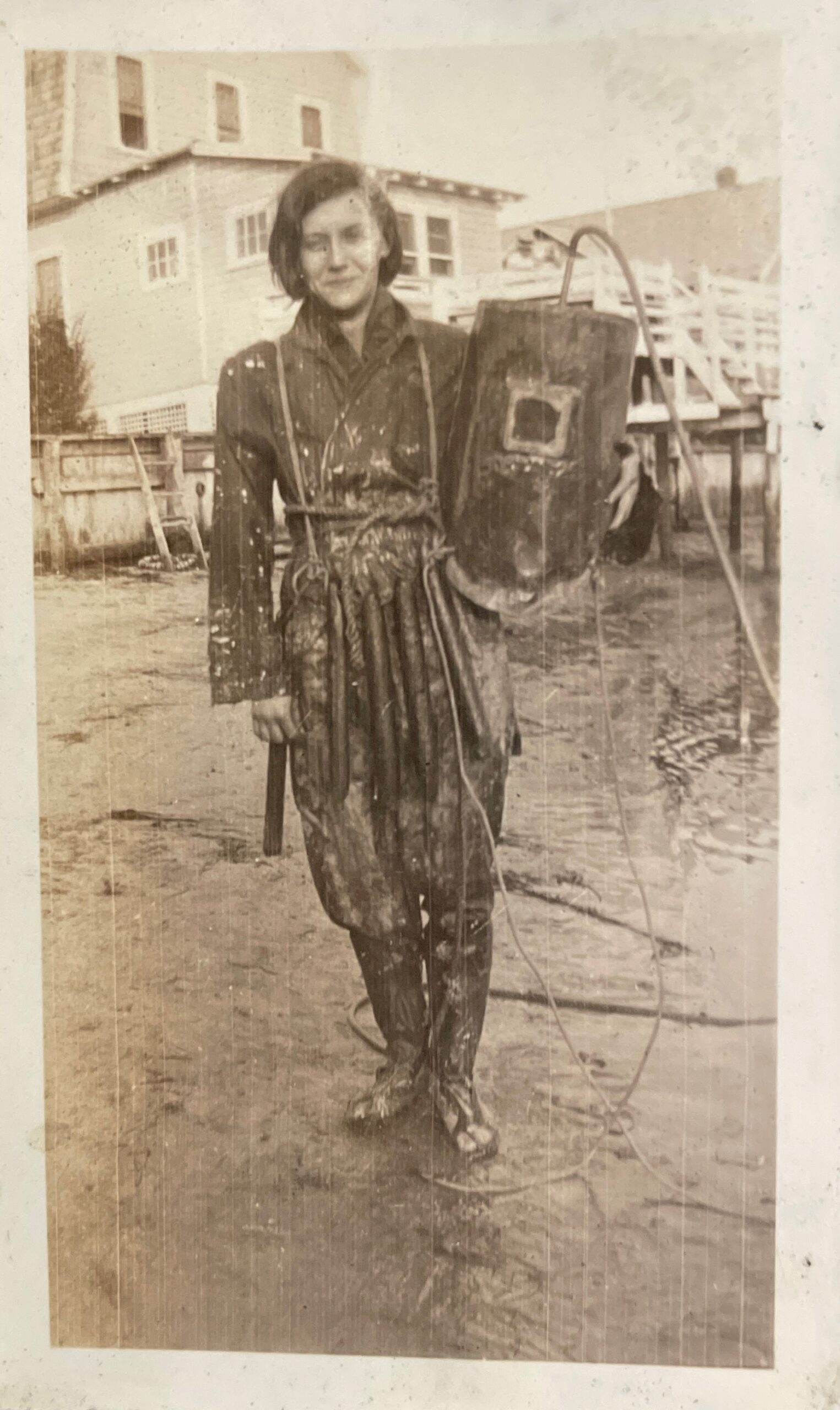
At Stone Harbor the Misses Wunder, daughters of Councilman Otto Wunder, donned the suit and went down in Snug Harbor, off 89th st., while Slane and Schwartz handled the apparatus from a boat.
The apparatus has also proven to be successful in the first commercial venture of its builders in helping and procuring information in trying to raise a larger barge for Captain Johnson which sunk in Cold Spring Harbor last year.
The barge, sunk in about twenty feet of water, is being salvaged. Every week-end the many friends of the two boys have visited them, all wanting to go down in the diving suit to explore the waters of Stone Harbor and dozens have made the trip under the water. Included among them are four girls, Evelyn Durkee, former scribe of the WYPS, Stone Harbor’s Young Peoples Organization and Mabel Sheer who is a Junior at Drexel College. The other girls are the daughters of Councilman Wunder.
(Indistinguishable word) the boys to go down the (indistinguishable words) life guards, his brother Paul; Lewis Madory, Morris Sheer, Clarence Baldwin, James Sword, Edward Lawson, Charles and Robert McNeil, who was beach surgeon at Stone Harbor this season.
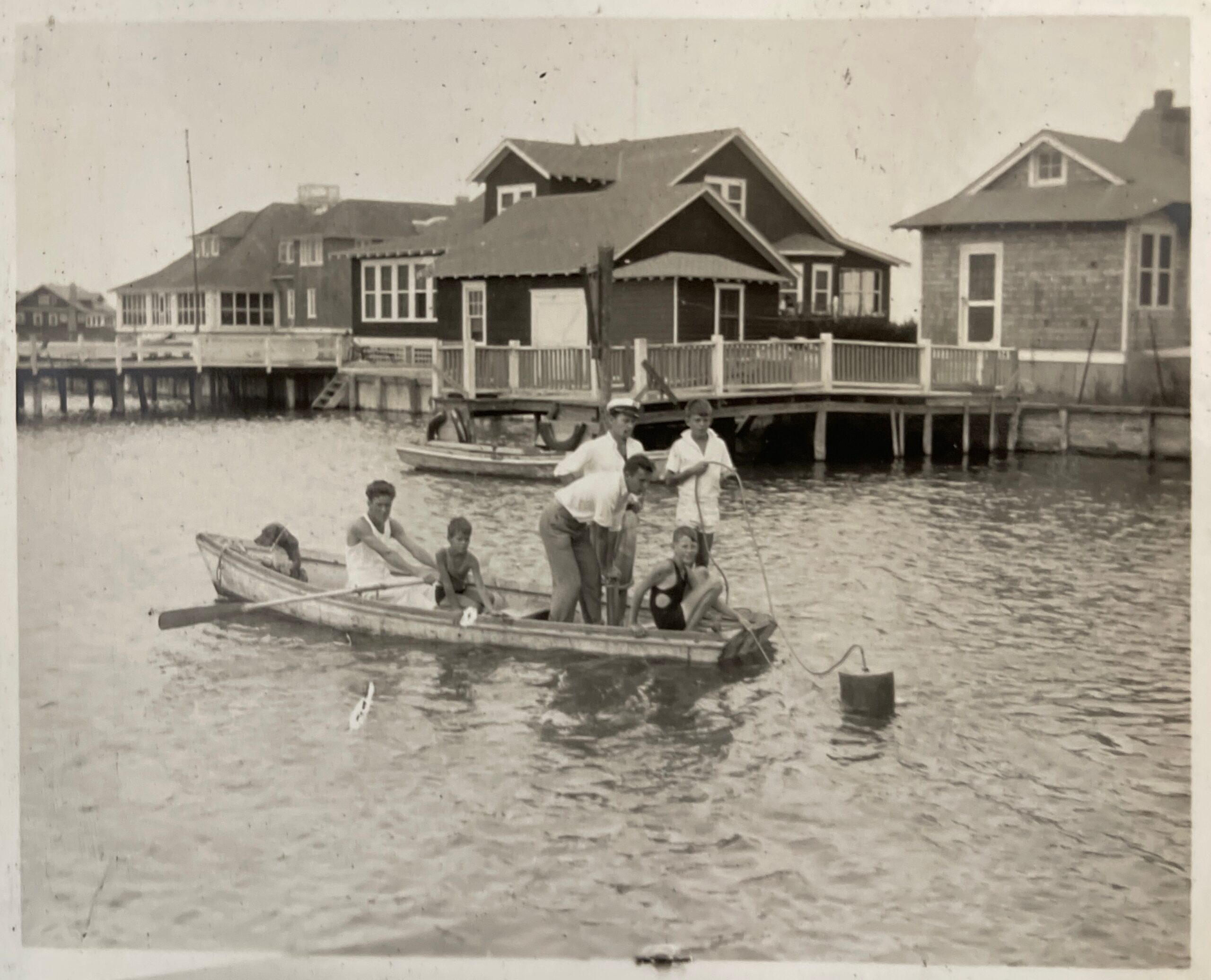
William Schwartz and Reid McNeill have descended to the greatest depth, as well as remained under water the longest time. Both of them treked across the Shelter Haven basin, a distance of over three blocks. Each remained under water for twenty-five minutes. Schwartz devoted an hour and a half (coming up several times to the boat) on the ocean bed half a mile off 95th street. Because of two sand bars in that section the ocean is only fifteen feet deep. The basin, however, is from twenty to twenty-five feet deep.
On the bed of the basin it is dark, but under the surface of the ocean it is light, the youthful divers report. In the ocean the water pressure is heavy; on the basin it is light.
Slane got the idea for the diving suit from a book “Artusus,” written by William Beebe, of the New York Geographical Society, who sailed in 1926 to the Saragosa sea to ascertain if fact or fiction was the basis of the old legend that wrecked ships were drawn to a section of that sea. Beebe, in his book, describes and pictures diving equipment he had constructed for the trip.
Securing the co-operation of Schwartz work on the suit was started Sunday, September 7 and completed the next afternoon about 3 o’clock, after 18 hours of arduous labor.
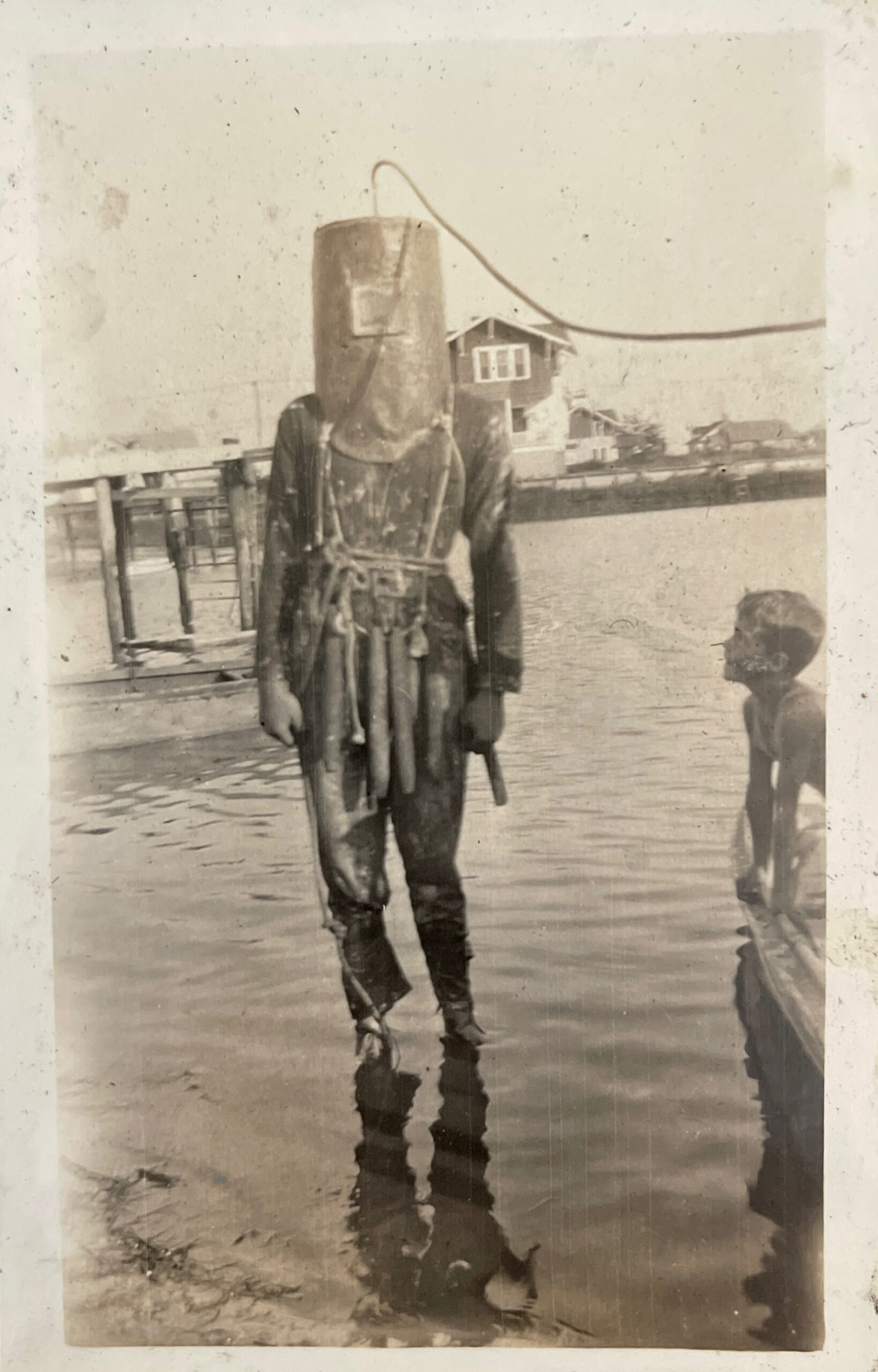
The apparatus was built from three pieces of the heaviest roofing copper obtainable in Stone Harbor. The head piece was fashioned from one, while the other two were used to fit over the front and back of the shoulders, to which section the headpiece was soldered.
Pieces of plate glass were inserted in the front and back of the headpiece. Through doubled barrelled automobile pump connected to a valve from an old auto tire tube, inserted in a hole cut on the top of the headpiece, air is pumped. The buoyancy of the water is overcome by twelve heavy (window) sashweights tied to the diver (around the waist). A rope is used to interchange signals.
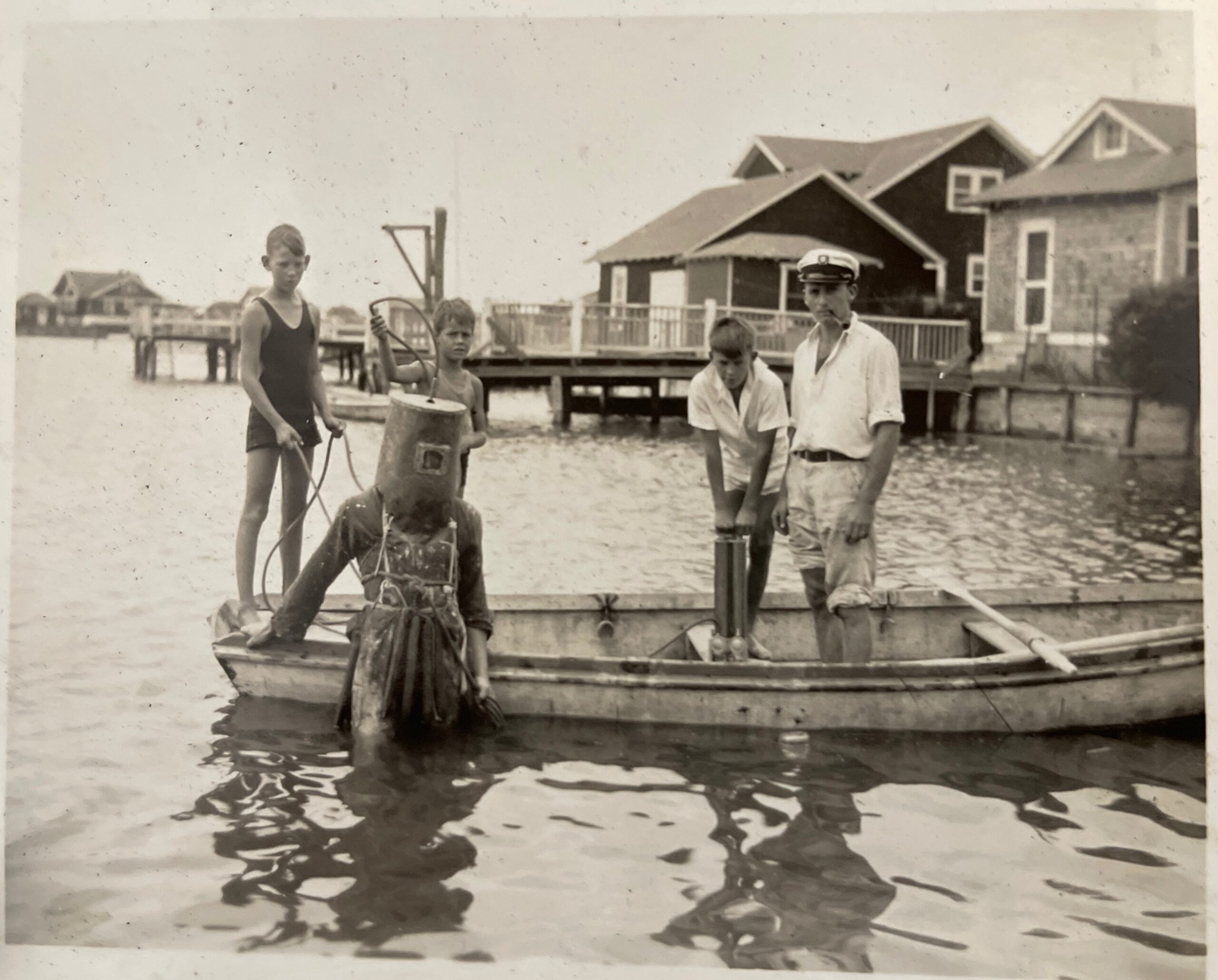
The hardest job falls to the pumpers, according to Slane, who declares the only sensation in submerging is when the water passes over the headpiece.
Jerry Slane has served on the Stone Harbor beach patrol from 1925 to 1929 and was captain of the lifeguards the last two years. This season he was promoted by borough council to beach director.
Pictures of the diving apparatus have appeared in newspapers of Philadelphia, New York, Atlantic City and other cities. Pictures and an article will also appear in a forthcoming issue of the Popular Mechanics magazine.”
Final Remarks: Well, there you have the entire article. Obviously, we are indebted to those persons who over many years have sought to save and even preserve such resource materials as this article for future generations to learn about and enjoy. It has been a pleasure to be able to present this remarkable story that took place at Stone Harbor in a bygone era. Hopefully, your attention has been held by this alluring news story as much as it was with me.
Postscript: A very brief history of diving is provided at this point to lend just a bit of additional historical background about this very interesting subject.
For your information, the early diving suits were primitive and quite uncomfortable, but they paved the way for modern diving equipment that allowed divers to explore the depths of the ocean or for that matter most bodies of water. In the early days of diving, divers relied on basic diving suits made of leather, canvas or rubber. These early suits were often quite cumbersome and offered a very limited range of abilities.
Apparently the earliest known diving suit was designed by a French nobleman, Pierre R e my de Beauve as far back as 1715. The suit was connected by two long hoses, one for breathing oxygen and one for exhaling carbon dioxide.
Some years later in 1797, a Polish man named Karl Heinrich Klingert became the first to develop a full-body diving suit made of a metal helmet, a wide metal girdle and pants as well as a vest made of waterproofed leather. With the use of a pump turret, air was supplied to the diver via a long, weighted tube.
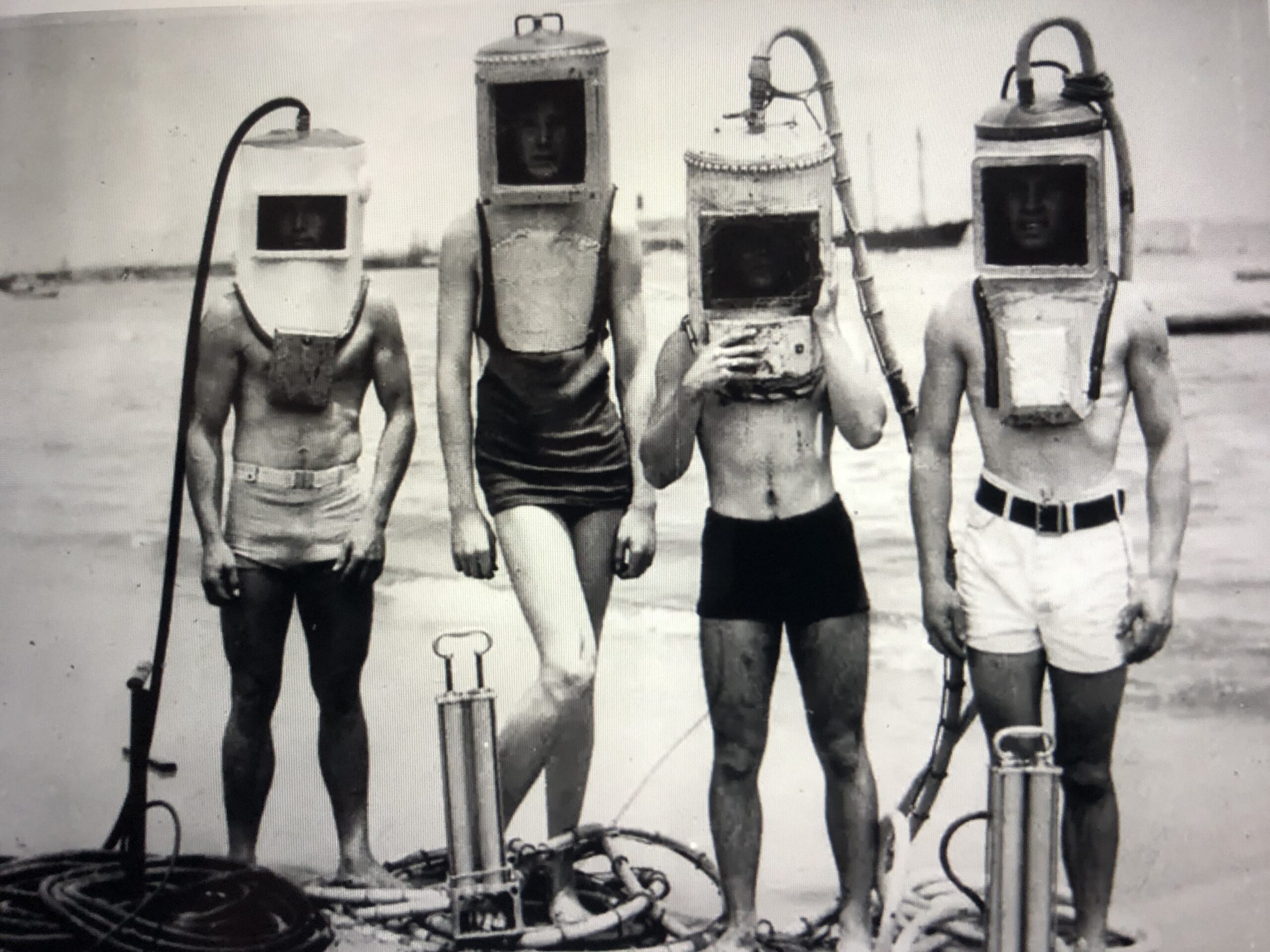
Finally a Google search on the subject about diving suits revealed what I considered a most interesting photographic image dated 1933 and taken just 3 years after the time of this very Stone Harbor article and post. Does this last 1933 image look somewhat familiar to you now? According to the brief caption for this very photograph, these 4 boys from Los Angeles are showing off their own homemade diving helmets and gear. Given such innovation all across this country we can now understand that there were other visionaries and diving enthusiasts, besides William Schwartz and James Slane of Stone Harbor, who were tinkering around and experimenting with the novel idea of creating a better and safer diving suit. Clearly these are the all-important imaginative and curious stirrings that arise within the minds of such men that move them to create and invent new things. “The rest, they say, is history!”
* * * * * * *
Check out the archival footage below of the boys and their diving suit in action!
